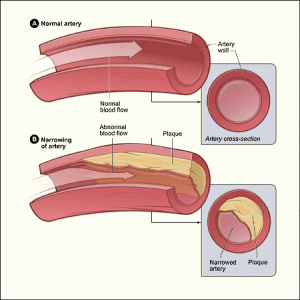Justice Ginsburg Undergoes Heart Procedure
Supreme Court Justice Ruth Bader Ginsburg is resting comfortably after undergoing a heart procedure. The 81-year-old Justice had a stent placed in her right coronary artery yesterday after complaining of some chest discomfort while exercising.
NPR legal correspondent Nina Totenberg, told their news division that Ginsburg is “awake and demanding work.” A Washington hospital spokesperson said that Ginsburg is expected to be discharged within 48 hours. She expects to be back at work on Monday.
Ginsburg is one of those “lucky” survivors of pancreatic cancer, whose cancer was discovered accidentally at an early, treatable stage.
The Coronary Arteries
The heart is obviously a very important organ. It has to work hard to pump blood throughout the entire body. The heart muscle requires oxygen to do it. Oxygen is carried in the blood through special blood vessels (called coronary arteries) that supply the heart muscle (myocardium) itself. Oxygen-poor blood is removed from the heart through the coronary veins. The coronary arteries are classified as “end circulation.”, They represent the only source of blood supply to the myocardium; there is very little overlap of blood supply. This is why blockage of these vessels can be so critical.
Two main coronary arteries, the left and right coronary arteries, run on the surface of the heart. The left coronary artery divides into two main branches- the left circumflex artery and the left anterior descending artery. Smaller branches of the coronary arteries cover the surface of the heart then dive into the heart to supply the myocardium, as well as tiny muscles called papillary muscles which help open the mitral and tricuspid valves, and the electrical conducting system of the heart.
There are some small connections(called anastomoses) between branches from the right and left coronary arteries. When two arteries or their branches join, the area of the myocardium receives dual blood supply. If one of the branches becomes blocked, the heart muscle will die from insufficient oxygen. However, if the process progresses slowly, the other artery may be able to grow enough to supply the necessary oxygen.
Getting to the Heart of the Matter
 Coronary artery disease (CAD) is the most common kind of heart disease. It is the leading cause of death in the United States.
Coronary artery disease (CAD) is the most common kind of heart disease. It is the leading cause of death in the United States.
CAD occurs when the blood vessels that supply blood to the heart muscle itself (the coronary arteries) become narrowed by a build up of plaque. Plaque is made up of cholesterol, fat, calcium and other substances from the blood.
Narrowing of the arteries leads to a decrease in blood supply to the heart muscle. This can lead to the symptoms of chest pain (angina) or even heart attack if the narrowing is severe enough, or if part of the plaque breaks off and blocks a smaller part of the artery.
What is Coronary Angioplasty and Coronary Stent?
In a coronary artery bypass, surgeons connect a blood vessel (taken from elsewhere in the body) to either side of a blocked artery to allow blood to flow freely again.
With an angioplasty, a catheter is inserted into the large artery in the groin, and is threaded up into the coronary arteries. The catheter has a small balloon on its tip. The balloon is inflated at the blockage site in the artery to flatten the plaque against the artery wall. After treatment, the guide wire, catheter, and balloon are removed. The hospital stay and recovery time for angioplasty is shorter than that of bypass. But about 35% of patients are at risk for more blockages in the treated area.
A stent procedure is frequently used along with balloon angioplasty. This involves placing a mesh-like metal device into an artery at a site narrowed by plaque. The stent is mounted onto the balloon-tipped catheter, threaded through an artery, and positioned at the blockage.
When the balloon is inflated, stent is opened. Then, the catheter and deflated balloon are removed, leaving the stent in place. The opened stent keeps the vessel open and stops the artery from collapsing.
Here’s a great video showing how the procedure is done:



























0 comments